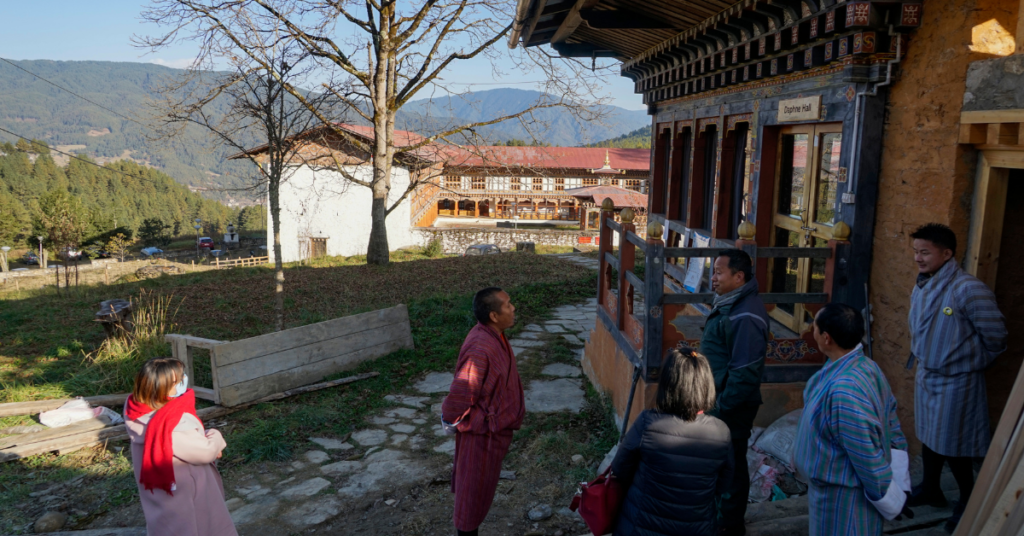January 30, 2021
Exciting Times Ahead!
On January 2, we celebrated Bhutanese Nyilo or winter solstice quietly in our homes under nationwide lockdown with no big celebrations, no gatherings of family and relatives, and no archery matches. As always, however, it was a time to reflect on the past year and consider possibilities for the months to come.
In November of 2020, I joined the Bhutan Foundation team as the Director of the Thimphu Office. In my first few months, I managed to make short field visits with the team to interact with our project partners and get a feeling for how things were moving on the ground. Although the battle with the pandemic is not over, in the spirit of optimism for the year 2021, here is an account of some of our experiences and perspectives from the field.
Wangduechhoeling Palace
The visit to the palace was a unique experience for me—a glimpse into Bhutan’s historic transition to a peaceful country under the Wangchuck Dynasty’s reign. Once completed, it will be a testimony to our rich history, tradition, and culture kept alive and shared with the world as a museum and cultural center.
While visiting, I was able to see the physical restoration and conservation work of the palace in its final stage, with the restoration on the Utse (central tower) nearing completion. It was inspiring to see how meticulously conservation work is done to preserve the architectural and structural integrity of the 19th-century palace. The painting restoration is so subtle, using natural mineral paint and traditional techniques, that it easily maintains the original grandeur and aesthetics of the palace. The architecture and the paintings are beautiful examples of the Bhutanese craftsmanship, skill, and ingenuity that existed even in that period of time. This further reaffirms the importance of preserving our dying arts and crafts skills and knowledge.
Besides the main structure restoration, the landscaping of the palace grounds, approach road, and construction of the museum café are also in progress. The work on the Utse is expected to be completed by June 2021. The next crucial phase of the project will be piecing together the Museum Plan. While the palace is being restored in its true essence, it will serve as a museum with modern digital and multi-media technology amenities.
For me personally, it was also heartening to observe that quite a number of the skilled workers engaged at the Wangduechhoeling Project site, especially in carpentry work, were young women. In the olden days, dzong construction carpenters were highly regarded and traditionally were men. This is now changing, defying gender stereotypes in the construction sector.


Ugyen Wangchuck Institute for Conservation and Environmental Research (UWICER)
After our time at the palace, the team made its way to UWICER as part of a familiarization visit and assessed the feasibility of setting up a noninvasive genetics lab in the facility. It was fascinating to listen to the environmental enthusiasts regarding their aspiration for UWICER to become a pioneering center for environmental research.
At the time of our visit, a training program was in progress for a group of tour guides learning about our rich biodiversity and our environmental conservation efforts. Tourists from all over the world visit Bhutan for many reasons, but a major attraction continues to be our values-based development philosophy and rich environment. These trainings are intended to enable the tour guides to advocate for environmental conservation and learn and create awareness among tourists about sustainable eco-tourism and waste management.

Jigme Singye Wangchuck (JSW) Law Library
With building restoration and environmental consciousness on the mind, it made sense also to visit the JSW Law Library project site to meet with the Project Manager and his team of engineers. The JSW Law Library structure, supported by the Karuna Foundation, is a one-of-a-kind aspirational building in Bhutan that meets the international standards of energy efficiency (EE building). The JSW team expressed that their skills and knowledge of EE buildings have widened through this experience working under the technical supervision of the experts from the Karuna Foundation.
I was impressed by how thoroughly energy efficiency was considered in all aspects of the construction—even beyond the common practice of wall insulation or double-glazed windows. For instance, the heating system for the structure uses a water-based floor heating system rather than heater-based, which consumes a lot more energy. Another salient feature that fascinated me was their drain water heat recovery system. Here, water circulation pipelines are insulated to preheat water so that less energy is consumed in heating water for showers, washbasins, and kitchens. Their lighting system is fully LED, and ventilation has a heat recovery system to further mitigate energy waste.
It’s no wonder, then, that this project has been drawing attention lately. We learned during our visit that the project site had received many visitors from government agencies, donors, and corporate engineers. Our team is excited for when the doors of the new library will open to Bhutan’s future lawyers and leaders to serve as an example of energy-efficient building and its capabilities in Bhutan.


These first few months have been a truly unique and interesting experience getting to know project teams and digging into work on the ground. Despite closures and ongoing restrictions, our teams in Thimphu and DC remain optimistic and look forward to making an even bigger impact with you this new year, 2021.
Best regards,
Norbu Dema
Director